32 Maple Trees: Types, Leaves, Bark – Identification Guide (Pictures)
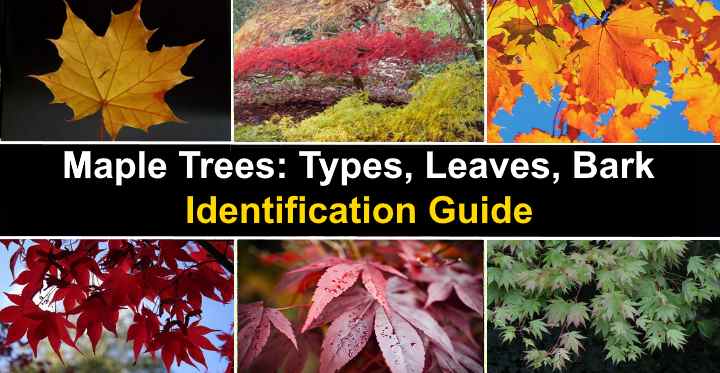
Maple trees are beautiful deciduous shade trees with leafy foliage. Maple trees have dark brown furrowed bark, small, winged fruits, and narrow reddish-brown twigs. Maple trees commonly have green lobed leaves that change their color to red, yellow, orange, and dark burgundy in the fall. The most identifiable feature of maple trees is their lobed leaves. Maples trees grow up to 150 ft. (45 m) tall.
Maple trees are flowering trees belonging to the genus Acer and the family Sapindaceae. Maples are closely related to horse chestnut trees.
This comprehensive guide provides detailed information about the most popular species of maple trees. You will find helpful pictures and descriptions that assist you in identifying the ideal maple trees for your garden. Additionally, the guide offers valuable insights into selecting the optimal locations in your backyard to cultivate maple trees.
Maple Trees Facts
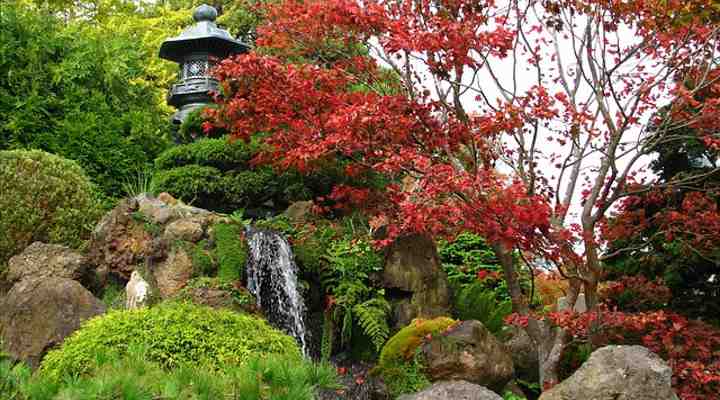
The ornamental maple tree provides stunning autumn color and there are many types to suit every garden
There are about 128 species of maple trees in the Acer plant genus. The two most common maples are the sugar maple (Acer saccharum) and the red maple (Acer rubrum). Other popular varieties of maple trees for gardens are the Amur Maple (Acer ginnala), Big Leaf Maple (Acer macrophyllum), and the Hedge Maple tree (Acer campestre).
Maple trees are renowned for producing the famous sweet maple syrup, extracted from the sap. While syrup can be made from any maple tree, it is the sugar maple tree (Acer saccharum) that yields the highest-quality syrup.
In addition to their culinary value, maple trees are prized for their quality timber. Maple wood, a hardwood variety, is utilized in crafting baseball bats, bowling pins, pool cue shafts, and hardwood flooring. The unique and decorative wood grain of maple makes it a popular choice for creating exquisite furniture pieces.
The striking maple leaf—especially from the sugar maple tree—is undoubtedly the tree’s most recognizable feature. A single stylized maple leaf with 11 points and deep indentations features prominently in the Canadian flag. The maple leaves are said to symbolize strength and endurance.
Maple Tree Leaves
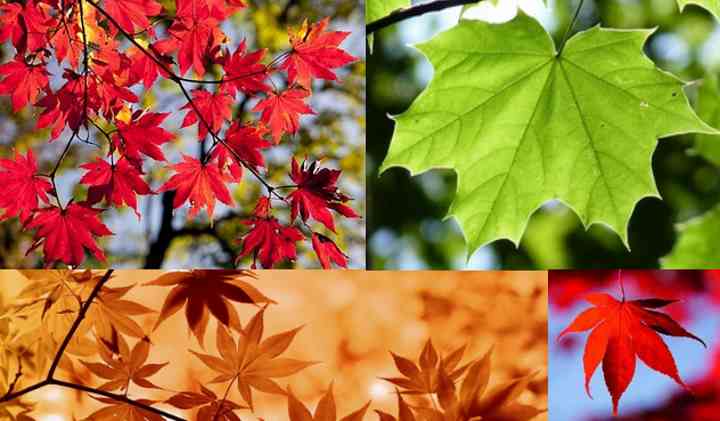
Maple leaf shape is the prominent way to help identify the type of maple tree
Maple tree leaves are characterized by their lobed structure, typically having between three and nine lobes. These broad leaves also display prominent veins, with many of them featuring serrated lobes. The number of lobes, the serration of the leaf margins, the depth of indentations, and the overall leaf shape all play a role in identifying specific maple species.
For instance, the sugar maple leaf is known for its five serrated lobes. However, when comparing sugar maples to silver maples, you’ll observe that silver maple leaves have deeper indentations compared to sugar maple leaves. These distinctions in leaf characteristics allow for differentiation between the two species.
The sugar maple leaves exhibit U-shaped indentations between the lobes, while red maple leaves display shallow V-shaped indentations. In addition, red maple leaves differ from sugar maples with their serrated margins and less pronounced depth of indentation between the lobes.
Maple tree leaves undergo a remarkable transformation in the fall, displaying stunning hues of red, yellow, orange, and dark burgundy. The foliage of certain maple species can have multiple colors simultaneously, ranging from vibrant yellow to rich red wine shades.
Maple leaves vs. sycamore leaves
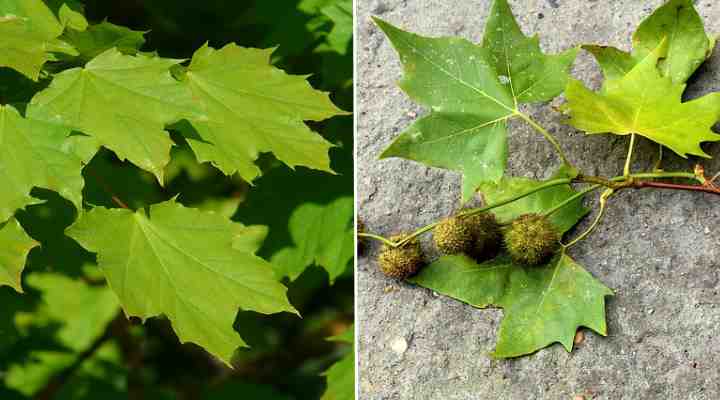
Some types of maple trees have similar leaves to sycamore trees. In the picture: maple leaves (left) and sycamore leaves (right)
Maple trees and sycamore trees share similarities in their leaf appearance. Maple trees typically have leaves with deep indentations between their lobes, while sycamore trees have leaves with shallower indentations. Furthermore, maple tree leaves grow in an opposite leaf arrangement, meaning that leaves emerge in pairs on opposite sides of the stem. On the other hand, sycamore leaves grow in an alternate arrangement, where leaves appear one by one along the stem.
Maple Tree Bark
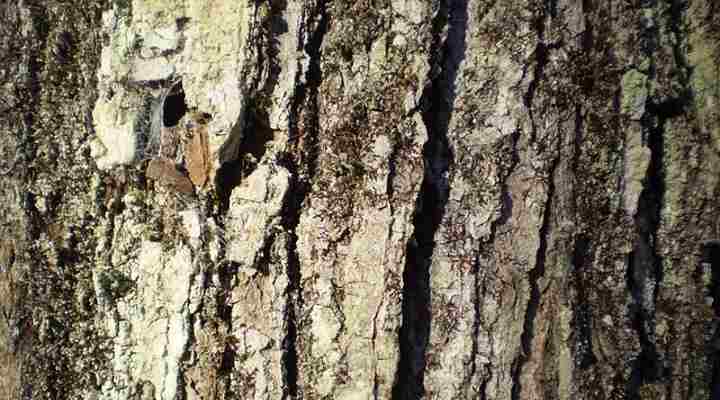
A close up picture of mature maple tree bark
Maple tree bark turns a dark brown color as the tree matures. Maple bark has wide strips running vertically up and down the trunk, separated by narrow grooves between the plates. Some species of maple trees have fewer furrows and less-pronounced fissures. Also, some maple tree species have smoother bark than others.
How to Identify Maple Trees
To accurately identify maple trees, focus on their distinguishing characteristics such as leaves, bark, and fruit. Maple trees typically have leaves with pointed lobes and noticeable deep indentations between them. These leaves have a dark green color. When examining the bark, take note of its initial smooth and gray appearance, which gradually develops into distinctive fissures and furrows over time. By observing these features, you can confidently recognize and identify maple trees.
Maple tree fruit looks like small wing-shaped leaves. The distinctive winged fruits are called samaras or helicopter seeds and contain a pair of seeds attached to a “wing” that carries the seed a long distance when it’s windy.
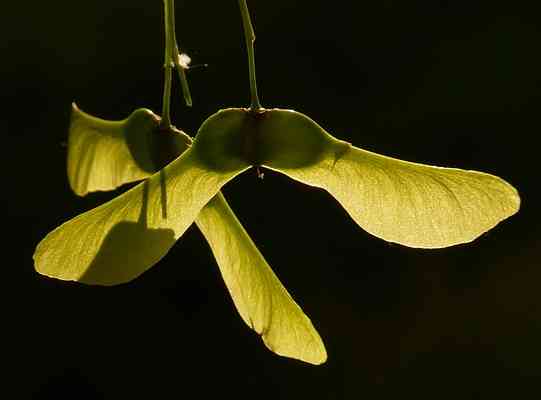
Maple tree fruit
How to Identify maple trees by their leaves
Maple tree leaves usually have three or five pointed lobes. Maple leaves have a deep green color that changes to yellow, red, burgundy, or orange in the fall. There are many variations between species of maple leaves.
How to Identify maple trees by their bark
Maple tree bark is generally gray-brown to reddish-brown. The vertical strips or plates on the trunk tend to peel and flake off. Silver maples have a flaky gray bark, whereas red maple trees have dark brown bark.
Sugar Maple Trees vs. Red Maple Trees
Red maple trees and sugar maple trees are the two of the most common species of maple. However, only the sugar maple tree is suitable for making sweet maple syrup. The sap of red maple tree is not as sweet as that of the sugar maple tree. The red maple tree is more of an ornamental garden landscape tree.
How can you tell the difference between sugar maple and red maple trees?
Sugar maple trees have leaves with smooth margins while red maple trees have leaves with serrated edges. The indentation between the lobes of sugar maple leaves is U shaped with a rounded base while the red maple trees have leaves with V shaped indentations.
Sugar maple trees have dark green leaves that turn red, orange, or yellow in the fall. Sugar maple trees bear 5-lobed leaves, with 3 large lobes and 2 small lobes. The space between the pointed lobes of sugar maple leaves forms a U-shaped indentation with a rounded base. The leaves of sugar maple trees can reach sizes of up to 8 inches (20 cm) in both length and width.
Red maple trees have light-green leaves with a silvery underside. These leaves have three or five lobes with serrated edges. Unlike sugar maple trees, the lobes of red maple leaves do not have deep indentations. Red maples are further distinguished by their pale gray bark, which is thinner compared to sugar maples. The leaves turn deep red in the fall.
Varieties of Maple Trees (With Pictures) – Identification Guide
Here are descriptions and pictures of the most common varieties of maple trees.
Sugar Maple Tree (Acer Saccharum)

Sugar maple (Acer saccharum) tree
Sugar maple trees are large, fast-growing deciduous trees with straight trunks, rounded crowns, and spreading branches. Sugar maple trees grow to between 40 and 80 ft. (12 – 24 m) tall. This low-maintenance tree grows well in full sun or partial shade. Sugar maples trees thrive in zones 3 – 8.
The sugar maple is the principal source for maple syrup, and it’s the national tree of Canada.
Maple tree leaves: Sugar maple leaves generally have five pointed lobes and deep green color. The large maple tree leaves turn a brilliant yellow, orange, or red color in the fall. Sugar maple tree leaves measure 3” and 6” (7 – 15 cm) long and wide.
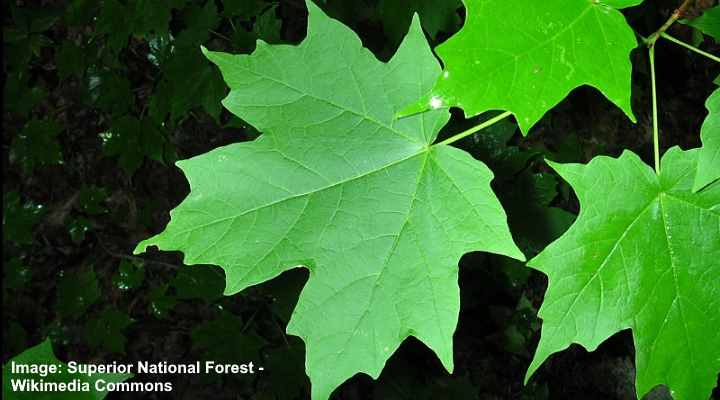
Sugar maple leaves
Maple tree bark: Sugar maple bark is a gray-brown color with long narrow grooves. As the tree matures, the bark starts to peel, giving the tree a shaggy look.
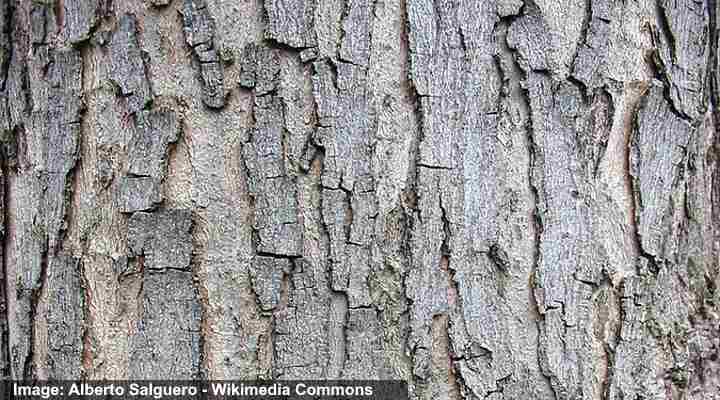
Sugar maple bark
Red Maple Tree (Acer Rubrum)
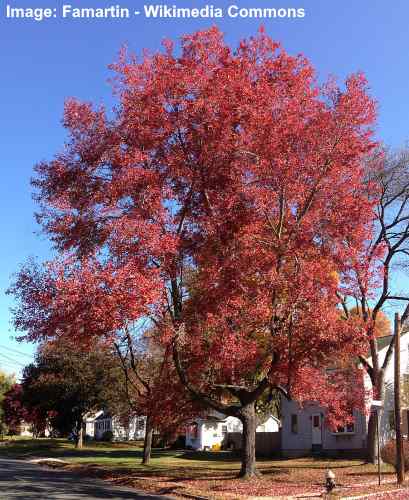
Red maple (Acer rubrum) tree
Red maple trees are stunning decorative landscape trees that have spectacular red foliage in the fall. Red maples have reddish flowers that appear in spring. The red maple leaves start as red color before turning green and then becoming yellow and red in the fall.
Red maples grow in North America and thrive in full sun or part shade. Fast-growing red maple trees grow to between 40 and 70 ft. (12 – 21 m). Grow red maples as landscape garden trees in zones 3 – 9.
Maple tree leaves: Red maple tree leaves are light green with white undersides. The leaves have between three and five lobes and are typically 2” – 4” (5 – 10 cm) wide and long. Unlike sugar maples and silver maples, red maple leaves have serrated margins and the indention between the lobes is not deep.
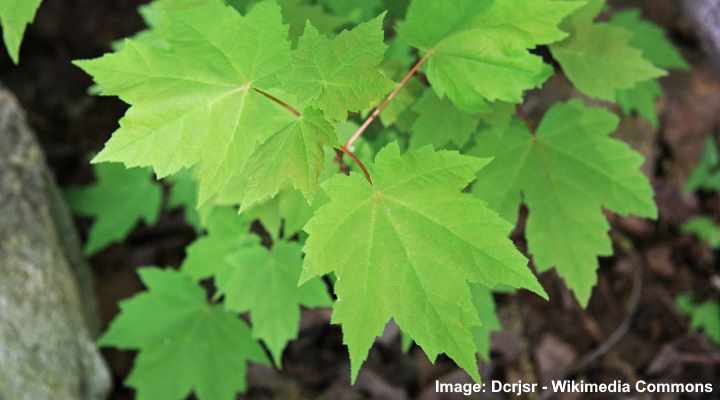
Red maple leaves
Maple tree bark: Red maple tree bark is thin, smooth, and gray when young and develops furrows with age.
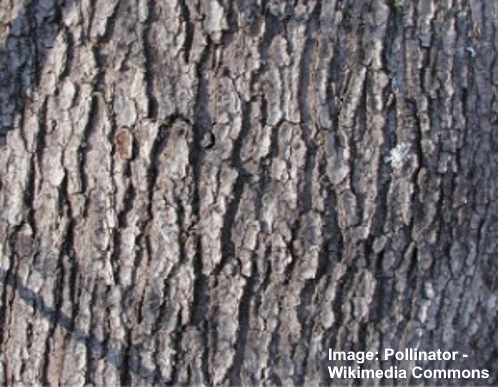
Bark of mature red maple
Japanese Maple Tree (Acer Palmatum)
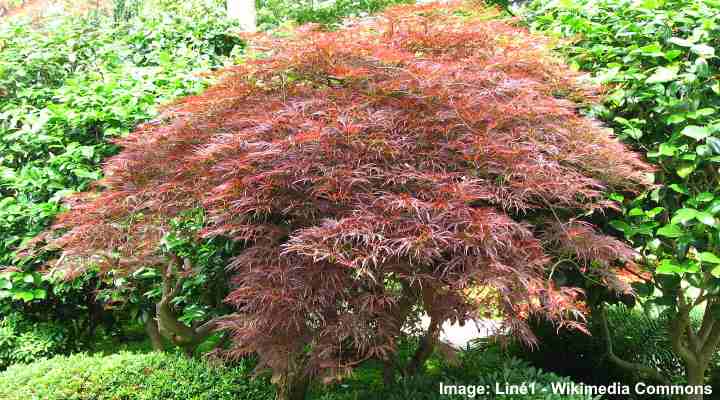
Japanese maple (Acer palmatum) tree
Japanese maple trees can grow up to 33 ft. (10 m) tall but some types of dwarf Japanese maples can look like small shrubby trees. The Japanese maple tree often grows as a small multi-stemmed tree that has a dome-like canopy or crown. Japanese maples have stunning foliage in the fall when their leaves turn yellow, bronze, or deep red color.
Japanese maple trees thrive in full sun to partial shade and grow in USDA zones 5 – 9.
Maple tree leaves: Japanese maple trees have palmately lobed leaves with five to nine serrated lobes. The leaves of the Japanese maple tree look like a hand with outstretched fingers. The light green leaves can grow up to 5” (12 cm) long.

The different Japanese maple cultivars vary in their leaf shape
Maple tree bark: Japanese maple tree bark is smooth and gray when young and develops furrows as it matures. The popular ‘Sango-Kaku’ cultivar has showy pink-colored bark, which looks stunning in winter landscapes.

Japanese maple bark
Silver Maple Tree (Acer Saccharinum)
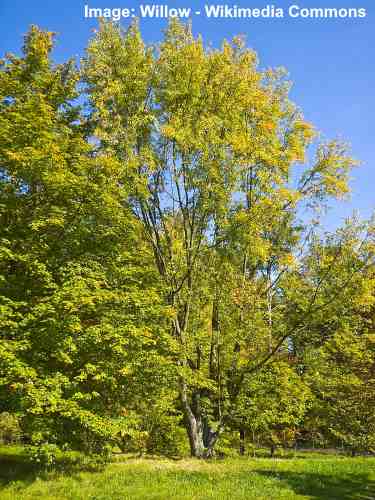
Silver maple (Acer saccharinum) tree
Silver maple trees are fast-growing deciduous trees that grow to between 50 and 80 ft. (15 – 25 m) with a spread of 36–49 ft. (11–15 m). Silver maple five-lobed leaves are green on one side and silver on the other. Silver maples thrive in zones 3 to 9.
Other names for the silver maple tree are creek maple, silverleaf maple, water maple, and swamp maple. Unlike other varieties of maple, silver maple tree leaves only have yellow-color in the fall.
Silver maple trees (Acer saccharinum) should not be confused with the sugar maple that has a similar botanical name (Acer saccharum).
Maple tree leaves: Silver maple tree leaves have five lobes with toothed edges. The leaves have deep indentations between the lobes. The silvery leaf undersides give this maple tree its common name.
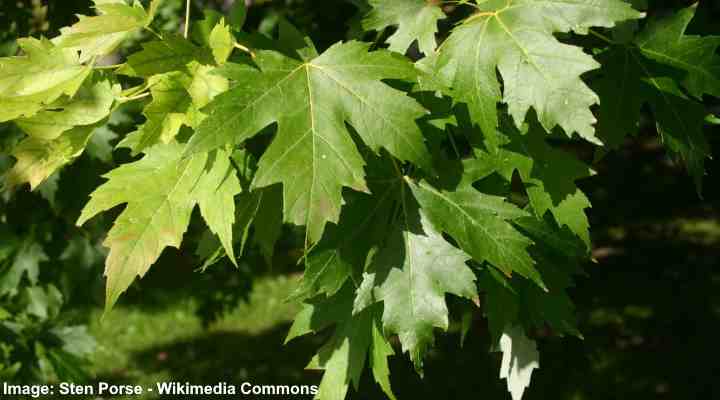
Silver maple leaves
Maple tree bark: Silver maple tree bark is smooth and silvery gray when young before becoming gray and shaggy as the tree matures.
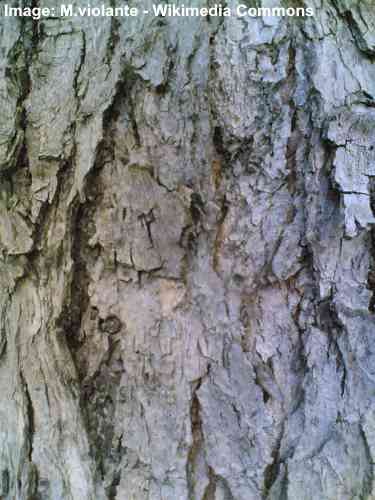
Silver maple bark
Boxelder Maple Tree (Acer Negundo)
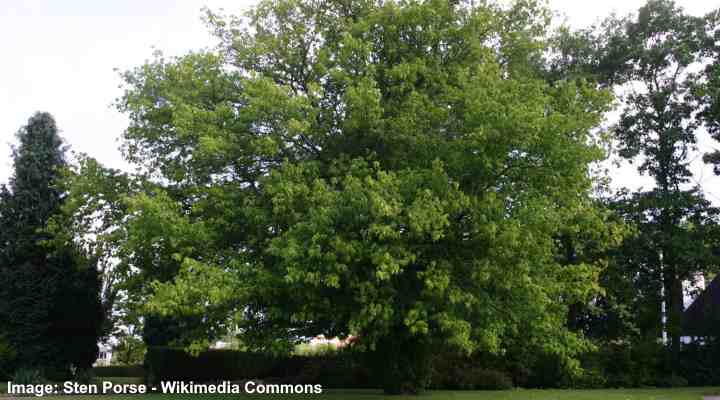
Boxelder maple (Acer negundo) tree
Boxelder maple trees are also called Manitoba maples or ash-leaved maples. The fast-growing tree grows up to 80 ft. (25 m) and sometimes has multiple trunks. Boxelder maples thrive in zones 2 to 9 and need to grow in full sun or partial shade.
Maple tree leaves: Boxelder maple tree leaves generally have three lobes that look like poison ivy leaves. Leaves are light green in spring and summer and turn yellow in the fall. The leaves have slightly serrate margins.
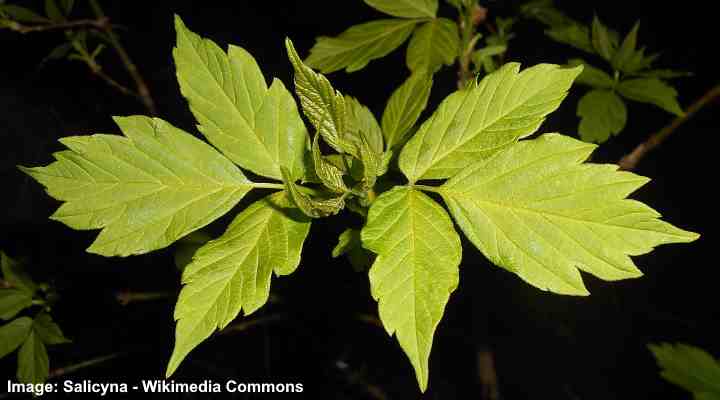
Boxelder maple leaves
Maple tree bark: Boxelder maple tree bark is pale gray to light brown with deep fissures that become scaly.
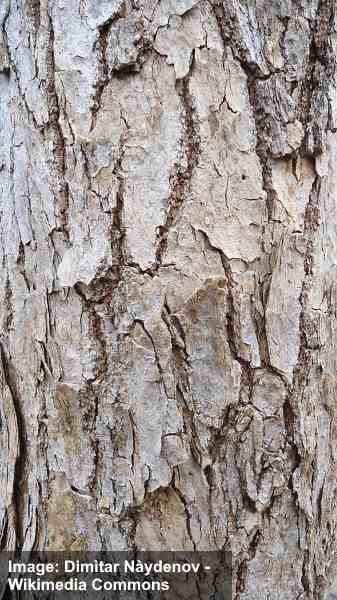
Boxelder maple bark
Norway Maple Tree (Acer Platanoides)
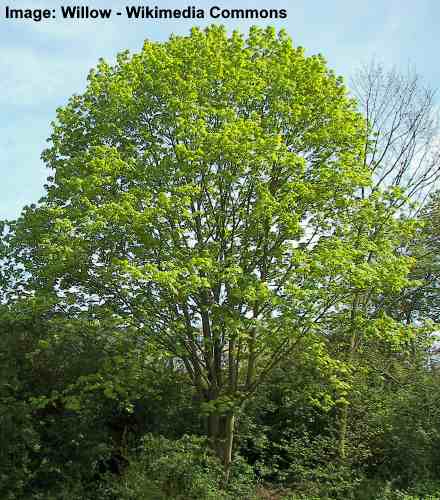
Norway maple (Acer platanoides) tree
Norway maple trees are deciduous trees with a broad, rounded crown and distinctive maple-type leaves. Native to Europe, Norway maples thrive in zones 4 to 7 and can grow in poor soil. Norway maples grow to between 65 and 100 ft. (20 – 30 m) tall.
Maple tree leaves: Norway maple tree leaves have five lobes and grow up to around 5” (12 cm) across. The lobed leaves have some teeth but generally have a smooth margin.
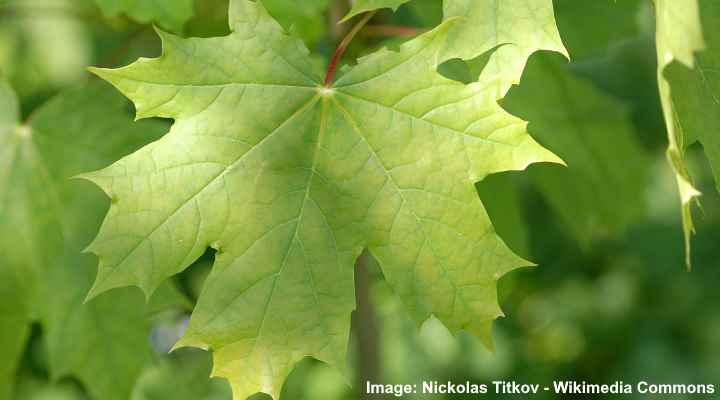
Norway maple leaves
Maple tree bark: Norway maple tree bark is gray-brown and has deep furrows as it matures.
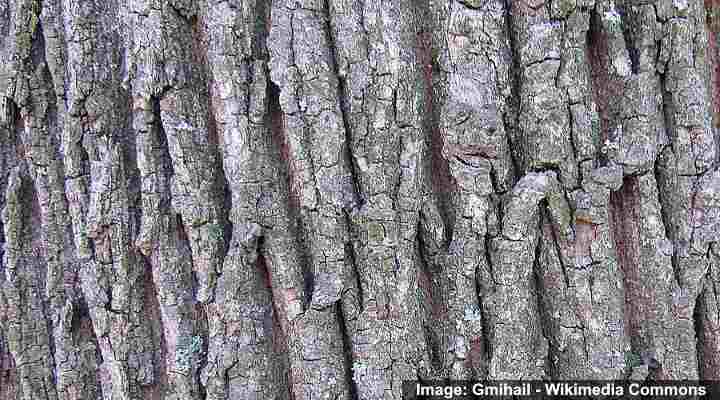
Norway maple bark
Paperbark Maple Tree (Acer Griseum)
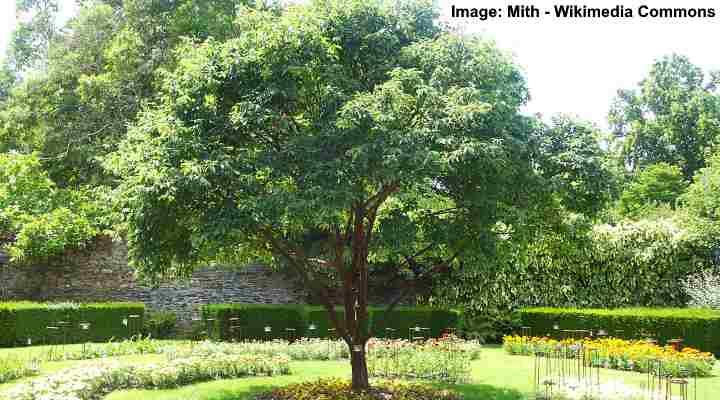
Paperbark maple (Acer griseum) tree
Paperbark maple trees have smooth, shiny, orange bark that peels off in strips. The papery bark can be in various shades of colors, including cinnamon, orange, and reddish-brown. Paperbark maples grow to between 20 and 30 ft. (6 – 9 m) tall and grow in zones 4 – 8.
Maple tree leaves: Paperbark maple tree leaves have three leaflets up to 4′ (10 cm) long. The maple leaves are dark green with blunted teeth on the margins.
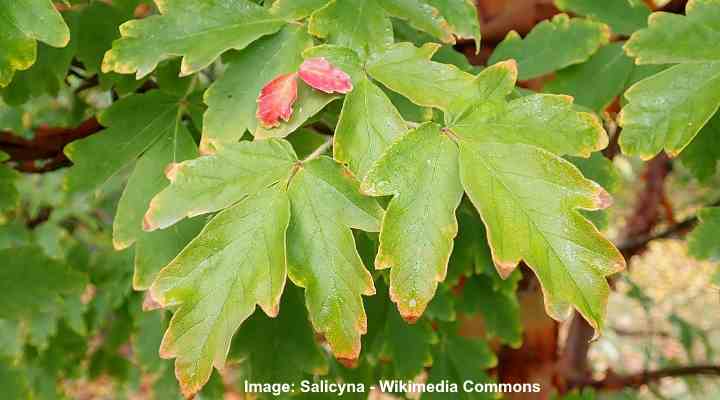
Paperbark maple leaves
Maple tree bark: Paperbark maple bark exfoliates with shards of thin, papery orange bark.

Paperbark maple bark
Sycamore Maple Tree (Acer pseudoplatanus)

Sycamore maple (Acer pseudoplatanus) tree
Sycamore maple trees are large deciduous trees that grow in full sun. Sycamore maples have a rounded growth with foliage made up of large, broad leaves. Although called sycamores, these trees are not true sycamores but are members of the Acer genus.
Sycamore maple trees grow to between 40 and 60 ft. (12 – 18 m) and are suitable for USDA zones 4 – 7.
Maple tree leaves: Sycamore maple tree leaves are like sycamore leaves. The five-lobed leaves have a rounded shape with serrated margins. Leaves grow to between 4” and 10” (10 to 25 cm) long.
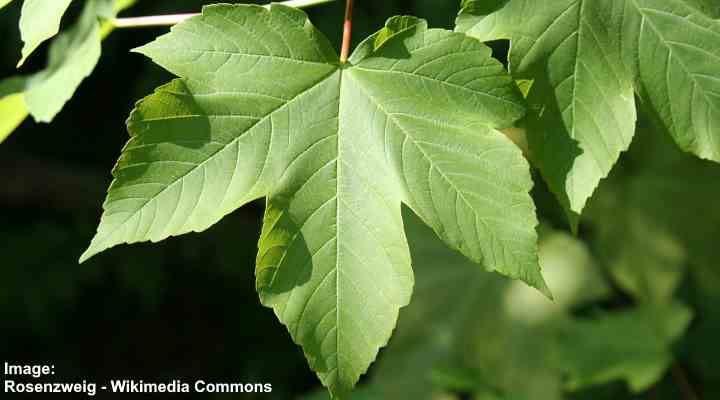
Sycamore maple leaves
Maple tree bark: Sycamore maple tree bark becomes rough and scaly as it matures. Under the exterior bark is a pinkish-brown inner bark.
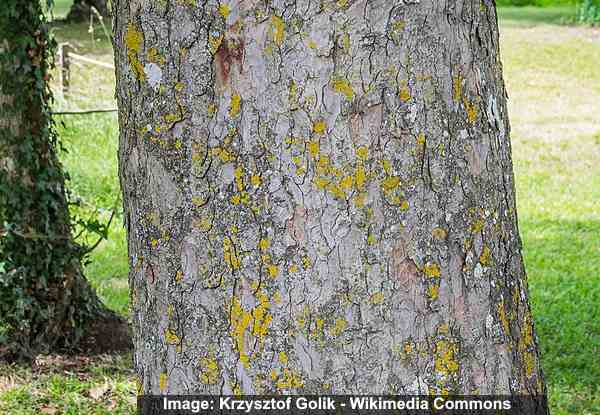
Amur Maple Tree (Acer ginnala)

Amur maple (Acer ginnala) tree
Amur maple trees are large multi-stemmed shrubs or small trees. The Amur maple tree grows to between 10 and 32 ft. (3 – 10 m) and has a dense, rounded crown. Low-maintenance small Amur maples thrive in zones 2 – 8 in full sun and poor soil.
Maple tree leaves: Amur maple tree leaves are 2” – 4” (5 – 10 cm) long with three or five lobes with toothed margins. Leaves turn red or yellow in the fall.
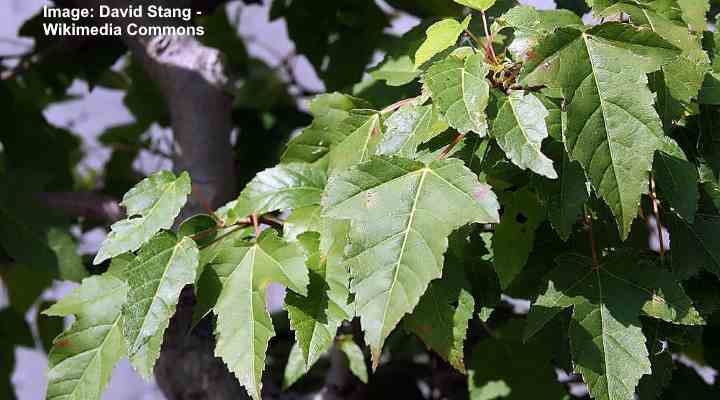
Amur maple leaves
Maple tree bark: Amur maple tree bark is smooth and gray that gradually become fissured as the tree matures.
Bigleaf Maple Tree (Acer macrophyllum)
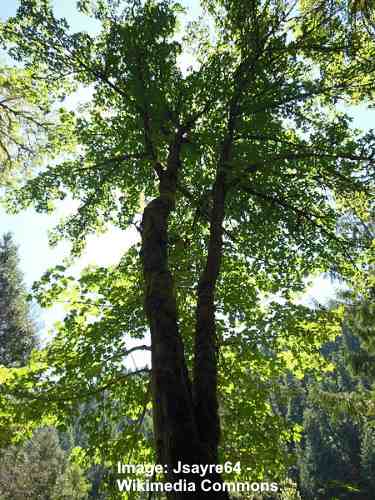
Bigleaf maple (Acer macrophyllum) tree
Bigleaf maple trees are native to North America and have the largest leaves on any maple species. Also called the Oregon maple, this giant tree grows up to 158 ft. (48 m) tall. The dark green foliage grows as a broad-rounded crown. Bigleaf maples thrive in zones 6 and 7.
Maple tree leaves: Bigleaf maple tree leaves are up to 12” (30 cm) across and have five lobes and deep indentations. Bigleaf maple leaves turn a spectacular golden yellow in the fall.
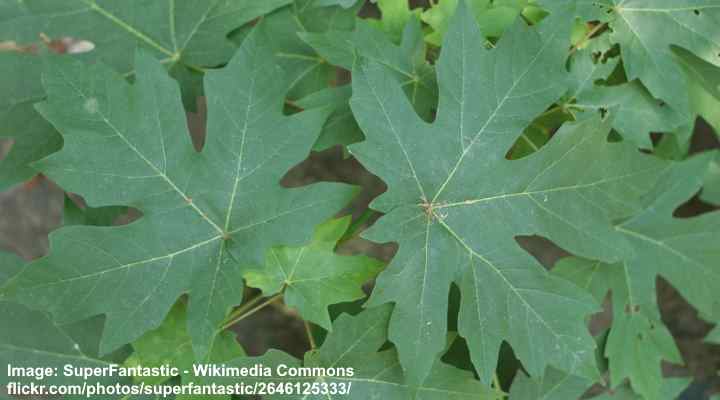
Bigleaf maple leaves
Maple tree bark: Bigleaf maple tree bark is reddish-brown with deep furrowing on mature trees.
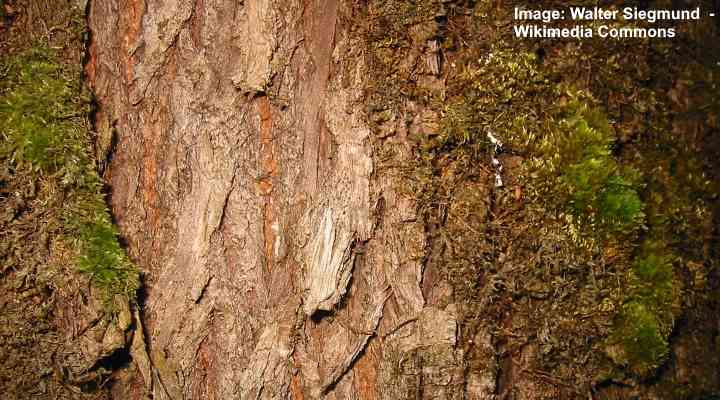
Bigleaf maple bark
Hedge Maple Tree (Acer campestre)
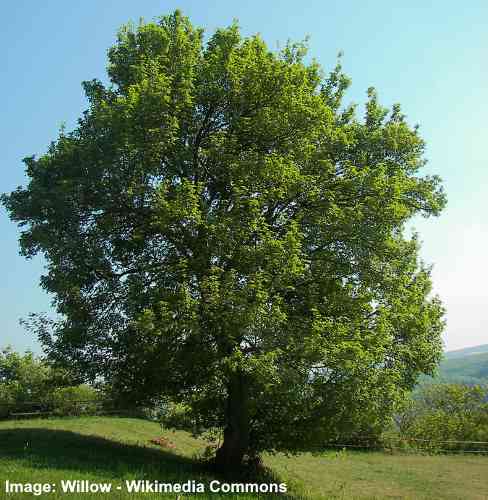
Hedge maple (Acer campestre) tree
Hedge maple trees grow in Europe and are medium-sized, fast-growing trees growing to between 50 and 80 ft. (15 – 25 m) tall. Also called the field maple, this deciduous tree is one of the last trees to turn color in the fall.
Maple tree leaves: Hedge maple tree leaves consist of three to five rounded lobes with a shiny, dark green surface. The leaves turn golden yellow in the fall.

Hedge maple leaves
Maple tree bark: Hedge maple tree bark has deep fissures. The unique feature of maple tree bark is its soft texture, almost like cork.
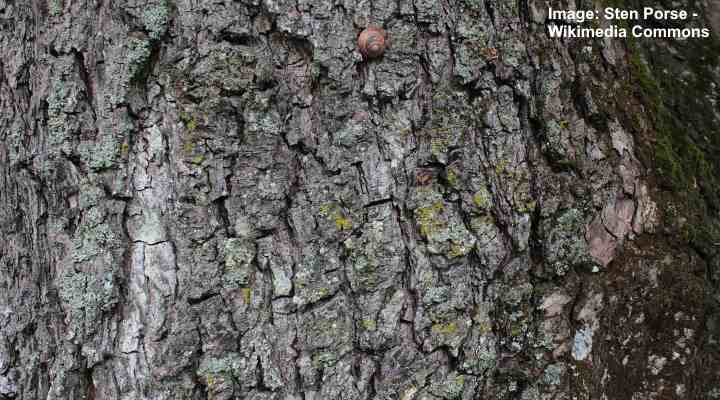
Hedge maple bark
Hornbeam Maple Tree (Acer carpinifolium)

Hornbeam maple (Acer carpinifolium) tree
Hornbeam maple trees are small trees native to Japan. Hornbeam maples have short trunks with a rounded growth. Unlike other species of maples, hornbeam maples don’t have lobed leaves. Hornbeam maple trees grow to between 20 and 30 ft. (6 – 9 m) tall and are hardy to zones 4 – 7.
Maple tree leaves: Hornbeam maple leaves are simple, unlobed leaves with serrated edges up to 6” (15 cm) long.
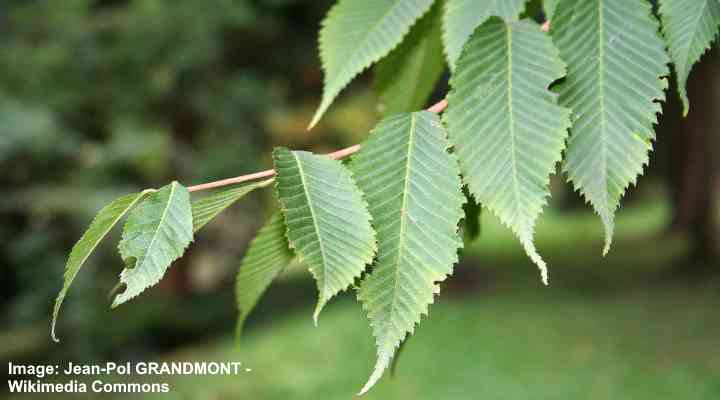
Hornbeam maple leaves
Maple tree bark: Hornbeam maple bark is dark gray to gray-brown that has a smooth feel.
Tatarian Maple Tree (Acer tataricum)
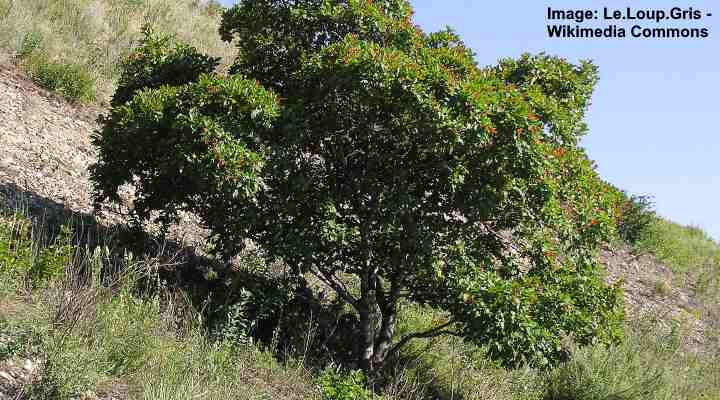
Tatarian maple (Acer tataricum) tree
Tartarian maple trees are small trees with slender trunks that grow up to 20 ft. (6 m) tall with a similar-sized spread. These European or Asian small maple trees thrive in zones 3 to 8, growing in full sun or partial shade.
Tartarian maple tree leaves are unlobed or with three or five shallow lobes and ovately-shaped. The leaves are a medium green color that turns yellow or red in the fall.
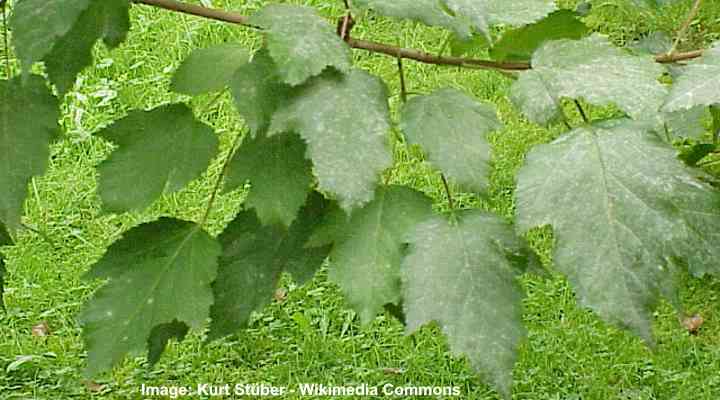
Tatarian maple leaves
Tartarian maple tree bark is thin and smooth in a pale brown color. The bark gradually becomes fissured as the plant matures.
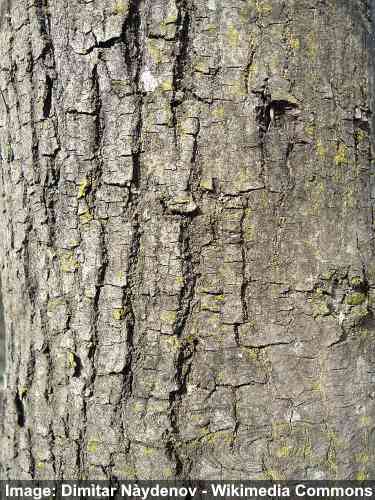
Tatarian maple bark
Vine Leaf Maple Tree (Acer cissifolium)
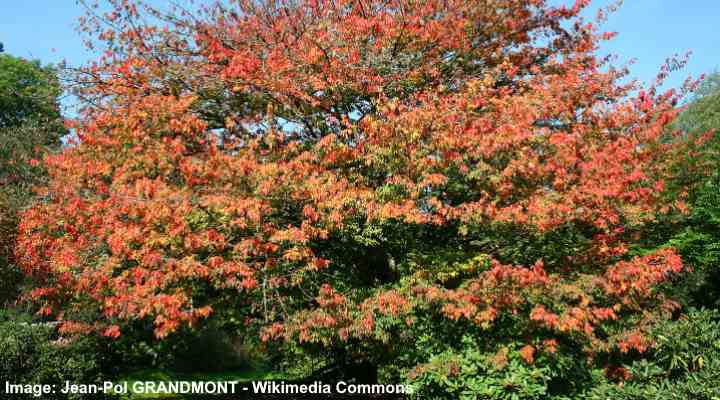
Vine leaf maple (Acer cissifolium) tree
Vine leaf maple trees are large shrub-like trees with a round top and dense foliage. As its common name suggests, the tree has leaves similar to spreading ivies. Vine leaf maples thrive in zones 5 to 8.
Vine leaf maple tree leaves are made up of three ovate leaflets with serrated edges. The medium green maple leaf color turns yellow to red in the fall.
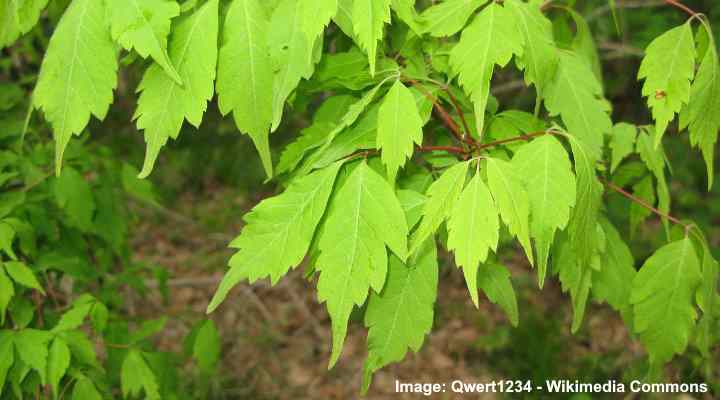
Vine leaf maple leaves
Vine leaf maple tree bark has smooth gray bark.
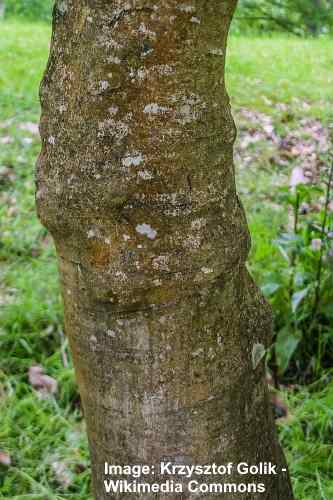
Vine leaf maple bark
Freeman Maple ‘Autumn Blaze’ Tree (Acer freemanii)

Freeman maple (Acer freemanii) ‘Autumn Blaze’ young tree
Freeman maples are stunning large maple trees with a large rounded grown, dense green foliage, and spectacular fall colors. The best example of a Freeman maple cultivar is the ‘Autumn Blaze.’ The ‘Autumn Blaze’ maple tree becomes a brilliant orange to crimson-red color in the fall. Freeman maple trees grow to between 50 and 60 ft. (15 – 18 m) in zones 3 to 8.
Freeman maple tree leaves have deep indentations between the lobes and are bright green color.
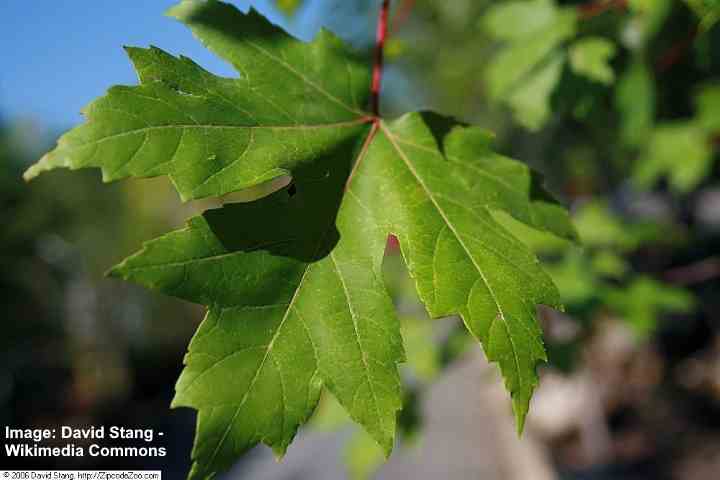
Freeman maple leaves
Freeman maple tree bark is smooth, thin, and gray that develops slight furrowing.
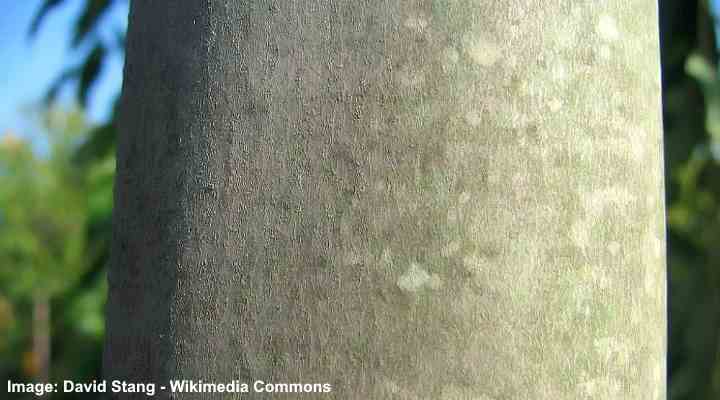
Freeman maple bark
Fullmoon Maple Tree (Acer shirasawanum)
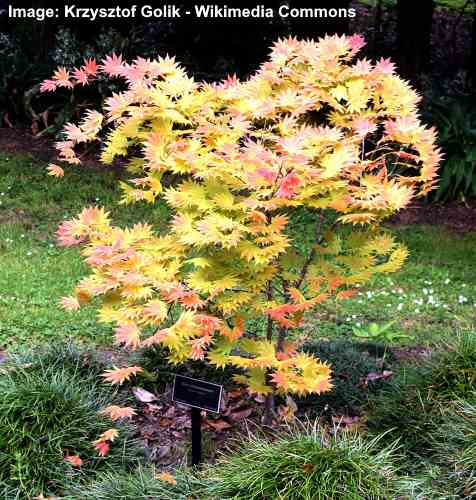
Fullmoon maple (Acer shirasawanum) ‘Autumn Moon’ tree
The fullmoon maple, or Shirasawa’s maple, is a sizeable shrubby tree native to Japan. Fullmoon maples grow to between 26 and 50 ft. (8 – 15 m) tall. This species of maple is closely related to the Acer japonicum, which is also called the fullmoon maple tree or Amur maple.
Fullmoon maple tree leaves have nine to thirteen shallow lobes that give the leaf a rounded shape. The shallowly incised lobes have serrated edges. Leaves are medium green that turns golden orange to dark red in the fall.
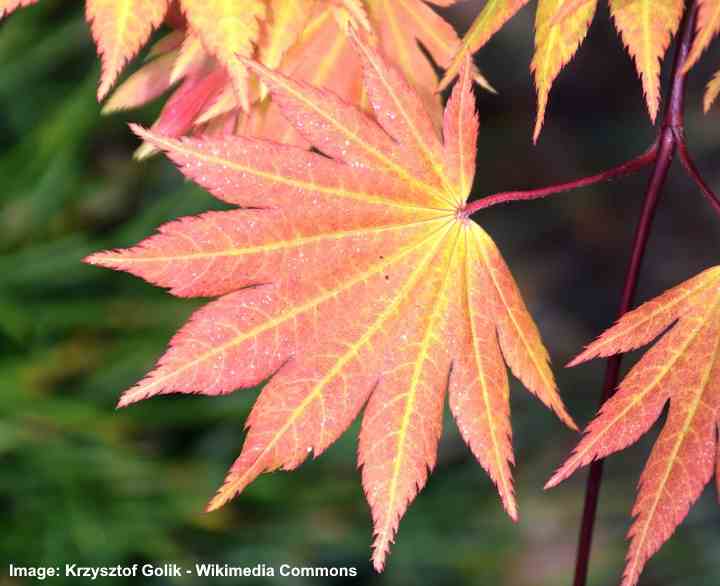
Fullmoon maple (Acer shirasawanum) ‘Autumn Moon’ leaves
Fullmoon maple bark is smooth and gray. Unlike many other maple species, the bark doesn’t become fissured as the tree matures.
Vine Maple Tree (Acer circinatum)
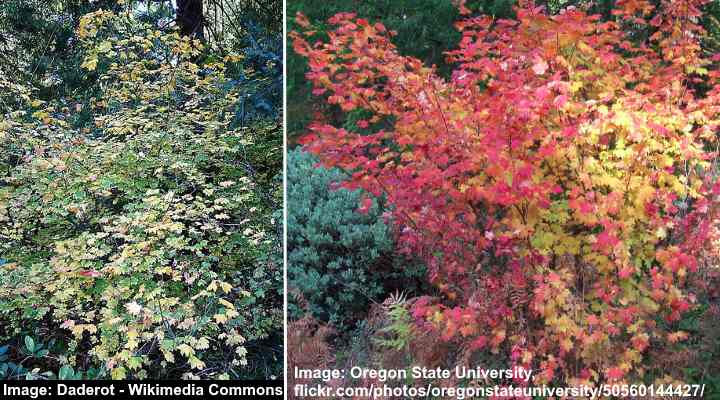
Vine maple (Acer circinatum) tree. Right image: autumn foliage
The vine maple tree is a multi-stemmed, medium-sized tree that can look like a large deciduous shrub. Native to North America, the vine maple is noted for its round leaves with seven to 9 palmate lobes, red-winged samaras, and tiny white and purple spring flowers.
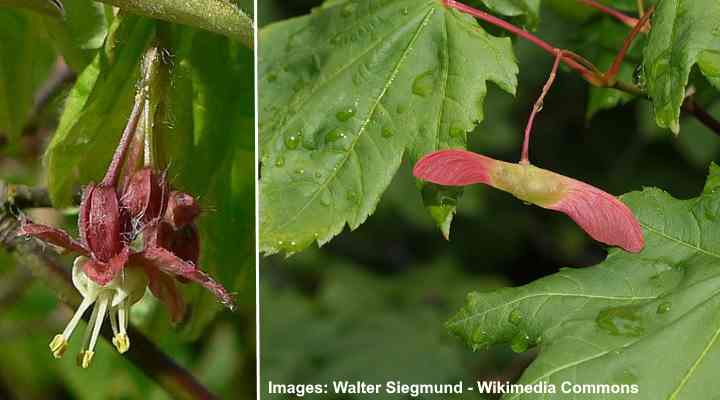
Vine maple flower and fruit (samara)
Suitable for growing in USDA zones 6 to 9, the vine maple tree grows 15 to 25 ft. (4 – 8 m) tall and up to 20 ft. (6 m) wide. In the fall, its attractive foliage turns shades of red and orange before the leaves drop.
Maple tree leaves: Vine maple tree leaves measure 3” to 5” (7.5 – 12 cm) long, have a circular shape, and feature several pointed lobes. The bright green leaves turn warm hues of red and orange in the fall.
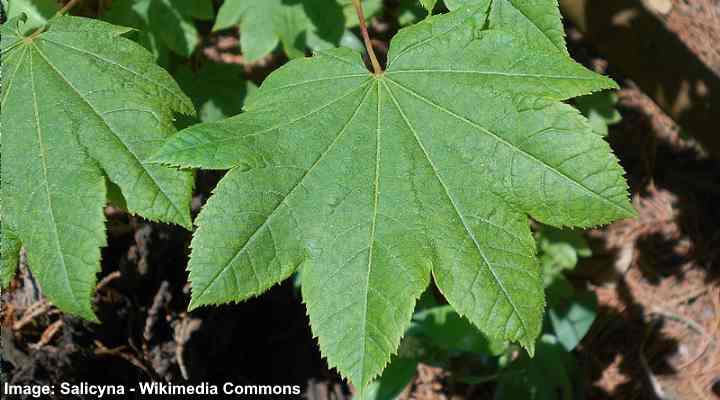
Vine maple leaves
Maple tree bark: Vine maple tree bark is reddish-green and relatively smooth.
Douglas Maple Tree (Acer glabrum var. douglasii)

Douglas maple tree in autumn. Right picture: leaves and fruit
The Douglas maple is a small tree with an attractive vase-shaped canopy and green leaves with serrated edges and three lobes. Growing 20 to 30 ft. (6 – 9 m) tall, the Douglas maple is an attractive landscape and shade tree for garden landscapes.
The deciduous tree has flat-topped clusters of small yellowish-green flowers, winged fruits with a reddish tinge, and heart-shaped leaves. The young twigs emerge red and gradually turn reddish-purple or gray as they mature.

Douglas maple flowers
Maple tree leaves: Douglas maple leaves are identified by their three to five pointed lobes. The green leaves turn yellow to orange or crimson red in the fall.
Maple tree bark: Mature Douglas maple trees have grayish to reddish-purple bark.
Bigtooth Maple (Acer grandidentatum)
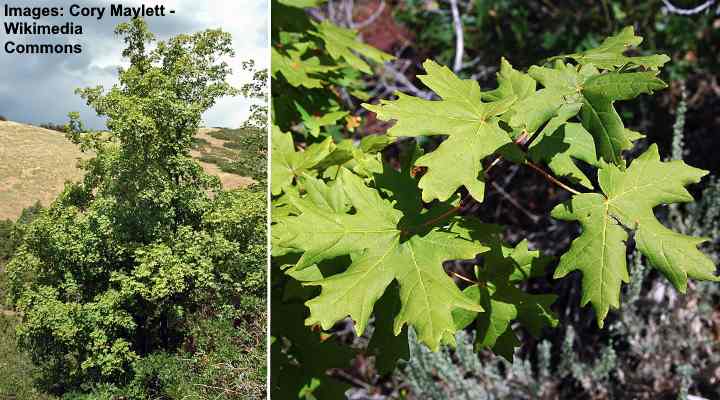
Bigtooth maple (Acer grandidentatum) tree and leaves
The bigtooth maple is a shrub-like tree with an upright irregular crown. Identifying features of this maple tree are its green leaves with three to five lobes and broad, shallow spaces between the lobes, yellowish-green flowers, and rose-colored winged samaras. The deciduous tree grows up to 50 ft. (15 m) tall and 25 ft. (7.5 m) wide.
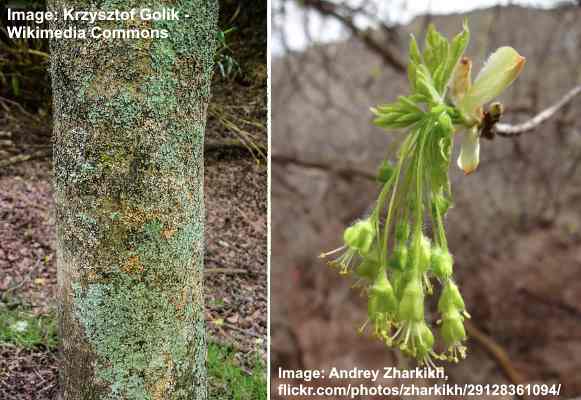
Bigtooth maple bark and flowers
Bigtooth maple leaves turn spectacular golden yellow to red colors in the fall. The lobed leaves measure 2” to 3.1” (5 – 8 cm) across and have rounded teeth on the lobes and a fuzzy underside. The maple thrives in the sun and partial shade in USDA zones 4 to 9.
Maple tree leaves: Bigtooth maple tree leaves have three to five toothed lobes with deep spaces between them. The dark green leaves turn deep red in the fall.
Maple tree bark: Bigtooth maple tree bark is dark brown and scaly.
Chalk Maple (Acer leucoderme)
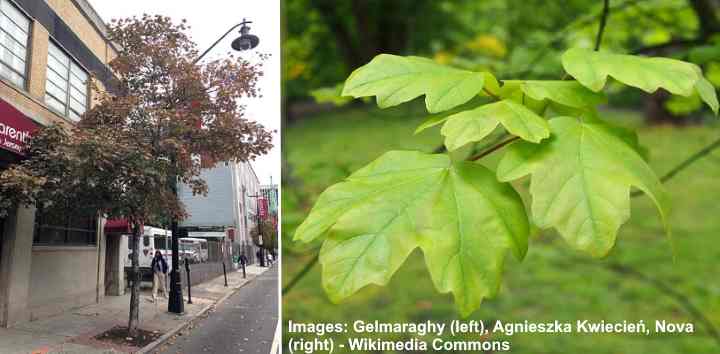
Chalk maple (Acer leucoderme) tree and leaves
Chalk maple is a small deciduous tree that is a smaller type of the popular sugar maple tree. This ornamental tree is native to North America and is identified by its light gray bark. In the landscape, the maple has a symmetrical, oval crown of dense foliage that turns yellow, orange, or red in the fall.
Also called whitebark maple or pale-bark maple, the attractive drought-tolerant tree grows 25 to 30 ft. (7.6 – 9 m) tall and wide. Its large leaves have rounded lobes and measure 4” to 8” (10 – 20 cm) across. Yellowish-green flower clusters appear in spring.
Maple tree leaves: Chalk maple leaves have shallow, rounded lobes with slightly fuzzy undersides. The leaves turn red and burgundy in the fall.
Maple tree bark: The distinguishing feature of the chalk maple tree is its light whitish-gray bark that becomes ridged and charcoal gray as it matures.
Striped Maple (Acer pensylvanicum)
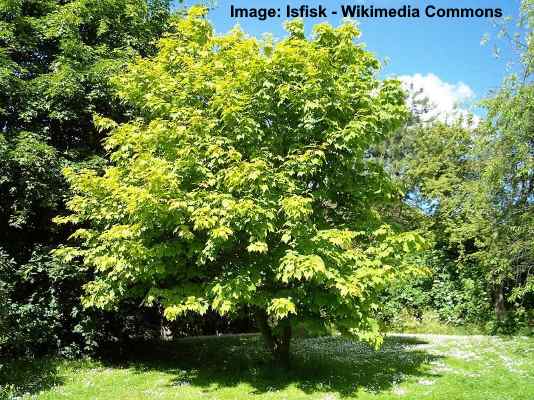
Striped maple (Acer pensylvanicum) tree
The striped maple is a small deciduous tree native to the eastern United States. The small decorative tree is characterized by its broad rounded shape with a flat, uneven crown. The tree’s leaves have shallow lobes and resemble a duck’s foot. Striped maples grow 16 to 33 ft. (5 – 10 m).
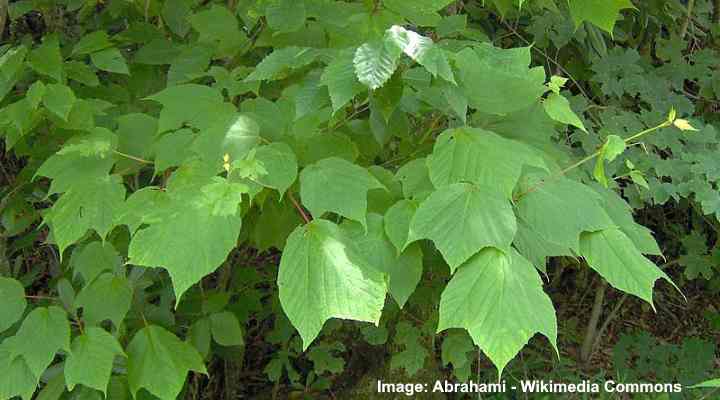
Striped maple leaves
As its name suggests, this maple variety has distinctive striped bark that is relatively smooth. The bark is mostly green, with white stripes running vertically. As the tree matures, the bark becomes brown with tan stripes. The maple is also called the goosefoot maple, moosewood, or moose maple.

Striped maple bark: young (left) and mature (right) tree
Maple tree leaves: The striped maple tree leaves have three shallow, forward-pointing lobes giving them the appearance of a goose’s foot.
Maple tree bark: The striped maple tree bark is smooth and green when young with white vertical stripes.
Mountain Maple (Acer spicatum)
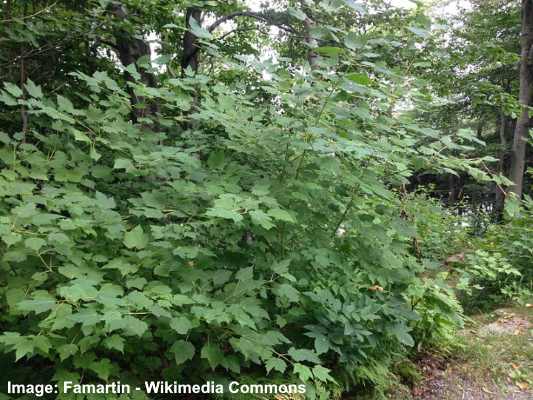
Mountain maple (Acer spicatum)
The mountain maple is a large multi-stemmed shrub or small tree with a spreading crown of light-green foliage. Growing 10 to 25 ft. (3 – 8 m) tall, the maple is identified by its three or five-lobed leaves with serrated margins hanging from slender stalks, thin gray-brown bark, and reddish-tan colored samaras.
Also called the dwarf maple, moose maple, or white maple, this understudy tree thrives in moist woodlands. The sap of the tree is sweet and is also used to make maple syrup. Its spectacular fall colors are golden yellow to vibrant red.
Maple tree leaves: The mountain maple tree leaves are identified by their irregularly toothed margins, three to five shallow lobes, and finely hairy undersides. They turn brilliant colors of yellow, orange, and red in the fall.
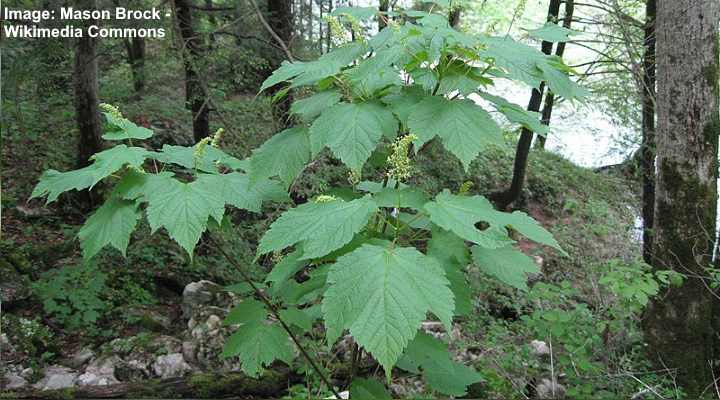
Mountain maple leaves
Maple tree bark: The mountain maple tree has thin, dull-gray to tan bark that is smooth on immature trees and gradually becomes scaly and dark brown.
Black Maple (Acer nigrum)
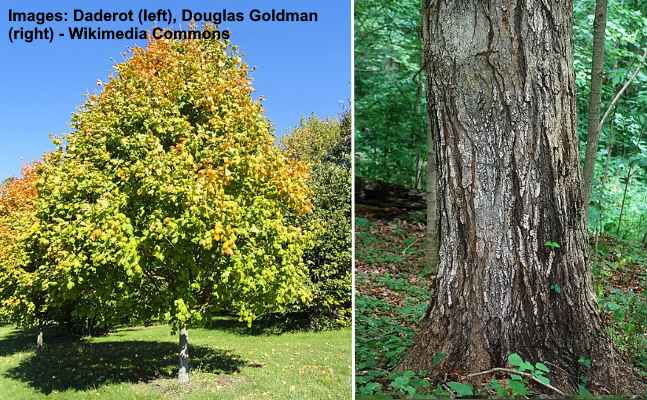
Black maple (Acer nigrum) tree and bark
The black maple is a tall deciduous tree native to North America and common in the midwestern United States. This maple species has green leaves with three or five lobes, deeply grooved bark, and clusters of yellowish-green flowers. The black maple thrives in USDA zones 5 to 7 and grows 70 to 100 ft. (21 – 34 m).
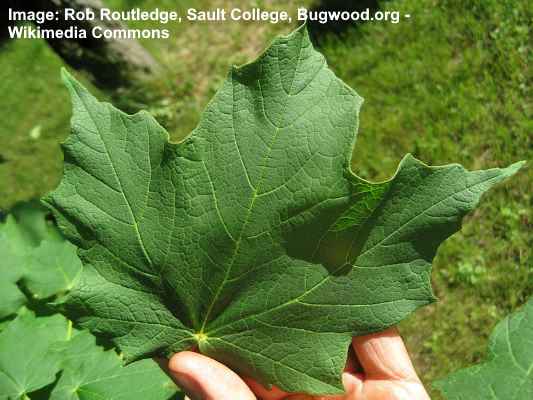
Black maple leaf
The black maple is closely related to the sugar maple (Acer saccharum). Its sap is also used in maple syrup production. Compared to the sugar maple, the leaves have a drooping appearance, fuzzy undersides, and a thicker petiole.
Maple tree leaves: The leaves on the black maple tree have three or five lobes and a slightly fuzzy underside. The bright green foliage turns from yellow to orange to red-burgundy in the fall.
Maple tree bark: The black maple tree bark is grayish-grown and develops rough, irregular furrows as it matures.
Florida Maple (Acer floridanum)
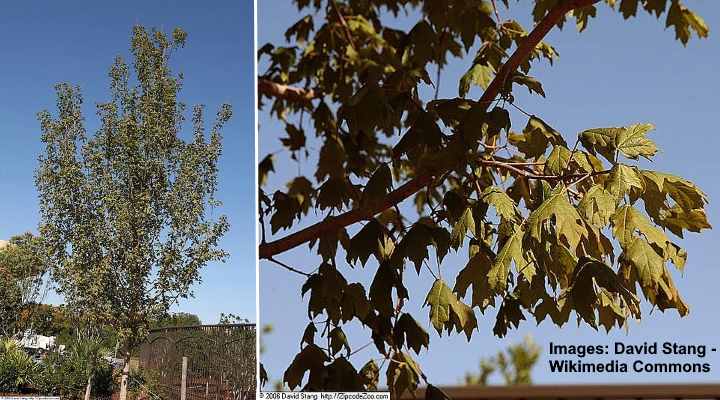
Florida maple tree and leaves
The Florida maple is a medium-sized decorative tree with an oval to rounded crown. Identifying features of the maple are its dark green leaves with three to five rounded lobes, greenish-yellow flowers, and two-winged samaras. The tree is suitable in a garden landscape where it grows 20 to 60 ft. (6 – 18 m) tall.
The native Florida maple is suitable for growing in USDA zones 6 through 9. This makes the beautiful tree ideal as a shade tree in southern gardens as far south as central Florida.
Maple tree leaves: The Florida maple tree leaves are characteristic maple-shaped leaves with three to five lobes with a pale color underside. The foliage turns vibrant orange and red in the fall.
Maple tree bark: The bark of the Florida maple tree starts smooth and gray, becoming shaggy and exfoliating in older specimens.
Three-Flowered Maple (Acer triflorum)
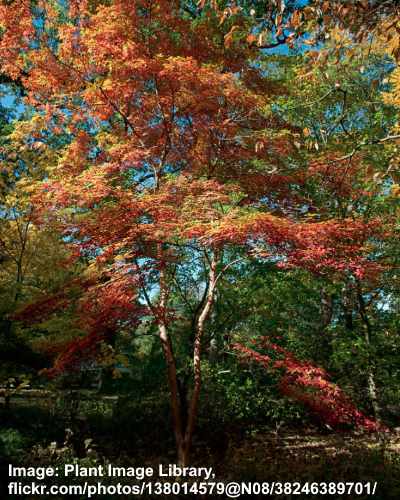
Three-flowered maple (Acer triflorum)
The three-flowered maple is a small to medium landscaping tree with spectacular light ash-brown exfoliating bark. The tree can reach a height of about 82 ft. (25 m) but is usually smaller at around 20-30 ft. (6 – 9 m).
The three-flowered maple has a rounded form, and its dense foliage is perfect for shade. The maple tree has trifoliate leaves consisting of three lanceolate blades. Additionally, its canopy turns brilliant red and orange in the fall.
The three-flowered maple is suitable for growing in USDA zones 5 to 7 in the sun or in partial shade. The small, slow-growing tree has four-season interest — lush foliage in spring and summer, brilliant orange and red colors in the fall, and attractive peeling light brown and tan bark in winter.
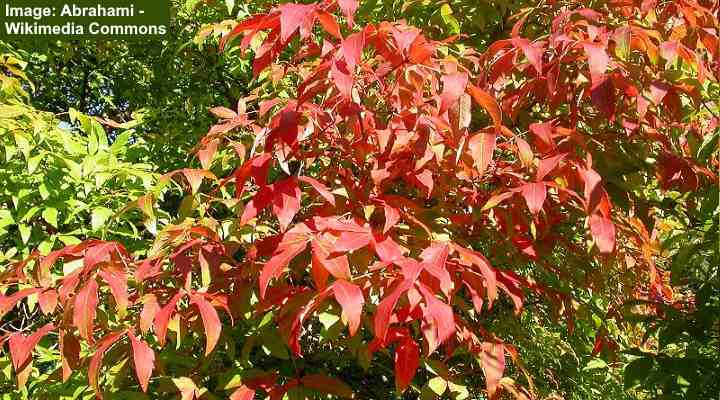
Three-flowered maple autumn leaves
Maple tree leaves: The three-flowered maple has easy-to-identify leaves because they are compound leaves that consist of 3 leaflets and have no lobes. In the fall, the three-toothed maple has some of the most spectacular colors of any maple, with scarlet, orange, purple, and golden yellow colors.
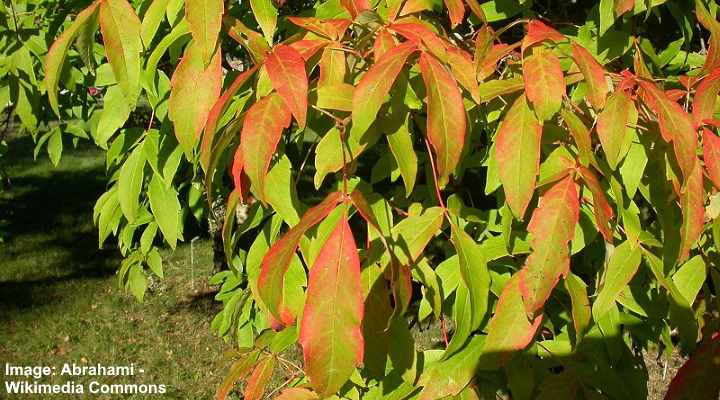
Three-flowered maple leaves
Maple tree bark: The unusual bark of the three-flowered is dark to light brown and peels to reveal cinnamon-red or cinnamon-orange inner bark.
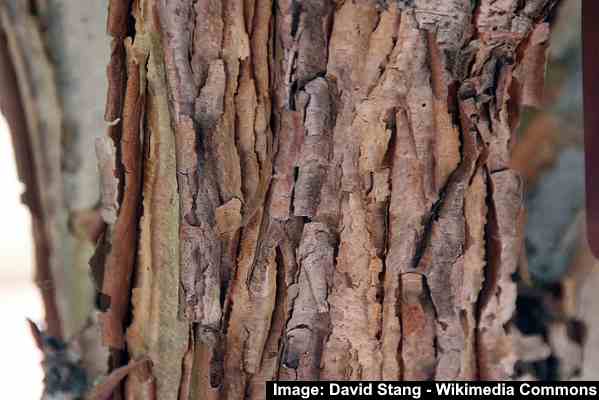
Three-flowered maple bark
Pointed Leaf Maple (Acer argutum)
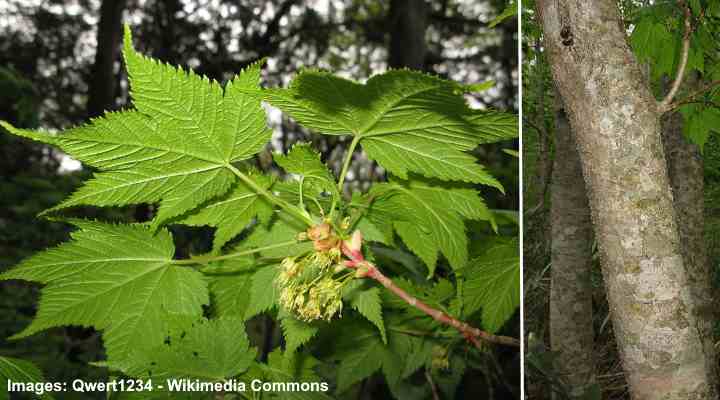
Pointed leaf maple: leaves, flowers and bark
Pointed leaf maple is an attractive tree with an upright habit and large leaves forming a dense canopy. Identifying features of the pointed-leaf maple are its large leaves with five lobes, each having tapering pointed ends, yellowish-green flowers, and warm orange colors in the fall. The medium-sized maples grow 33 ft. (10 m) tall.
The pointed-leaf maple is native to Japan and grows in woodlands and near bodies of water. The maple is also a source of sugary sap, and this can be made into maple syrup.
Maple tree leaves: The pointed-leaf maple tree leaves have five pointed lobes with serrated margins. They turn from green to yellow and orange in the fall.
Maple tree bark: The bark of the pointed-leaf maple tree is smooth with patches of green, gray, and tan.
Sycamore Maple ‘Brilliantissimum’ (Acer pseudoplatanus ‘Brilliantissimum’)
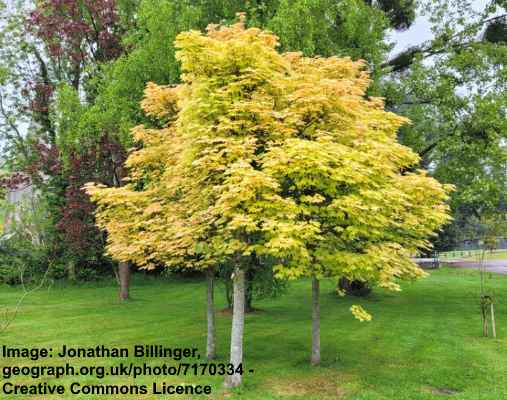
Sycamore maple ‘Brilliantissimum’ (Acer pseudoplatanus ‘Brilliantissimum’)
The sycamore maple cultivar ‘Brilliantissimum’ is an eye-catching deciduous tree thanks to its pink foliage. This small, slow-growing landscape tree has large, colorful leaves with three to five lobes. These emerge salmon pink, turn yellowish-green, then cream in the summer. The ornamental tree grows 20 to 30 (6 – 9 m) tall and wide.
The sycamore maple tree performs best in cooler climates in USDA zones 4 to 7. Planted in full sun or partial shade, the small maple is an ideal shade tree with interesting foliage.
Maple tree leaves: The sycamore maple tree leaves are colorful with pink shrimp colors from early spring until summer, where they turn dark green before becoming orange in the fall. The five-lobed leaves have toothed margins.
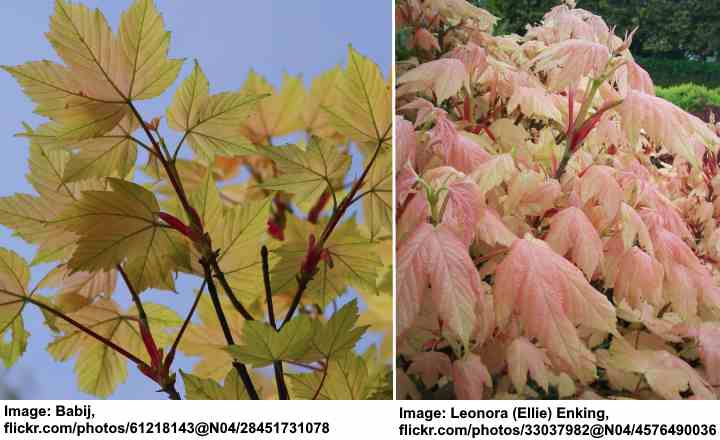
Sycamore maple ‘Brilliantissimum’ leaves
Maple tree bark: The bark on the sycamore maple tree is charcoal-gray and flakes to reveal an orange inner bark.
Coral Bark Maple (Acer palmatum ‘Sango-kaku’)

Coral bark maple (Acer palmatum ‘Sango-kaku’)
The coral bark maple tree is an eye-catching ornamental small maple with a vase-shaped habit and foliage of attractive green leaves and red margins. The green and red maple leaves have five lobes and are heavily toothed. The tree’s foliage turns soft yellow-orange, contrasting nicely with the coral-red branches and twigs.
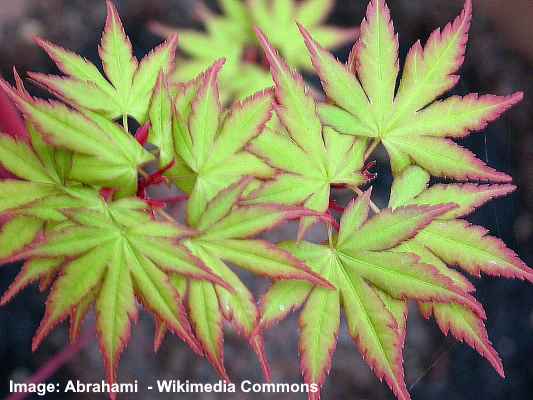
Coral bark maple leaves
Suitable for USDA zones 4 to 8, the coral bark maple grows 20 to 25 ft. (6 – 7.5 m) tall and up to 20 ft. (6 m) wide.
Maple tree leaves: The coral bark maple tree leaves are pinkish yellow before turning green and then yellow-orange in the fall.
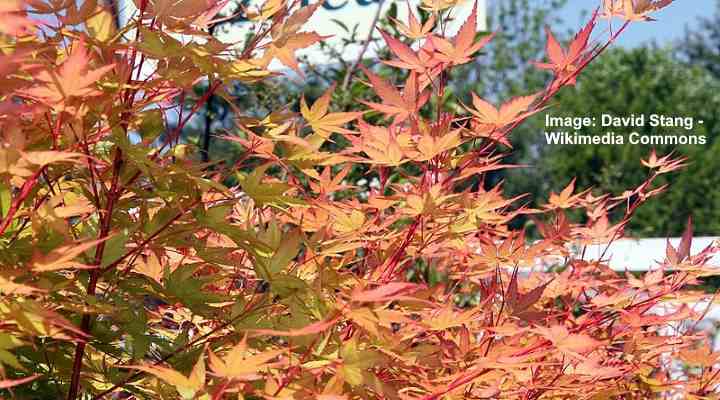
Coral bark maple autumn leaves
Maple tree bark: The stunning bark on the coral bark maple is a bright, coral-red color that is most vibrant in winter and spring.
Fernleaf Full Moon Maple (Acer japonicum ‘Aconitifolium’)
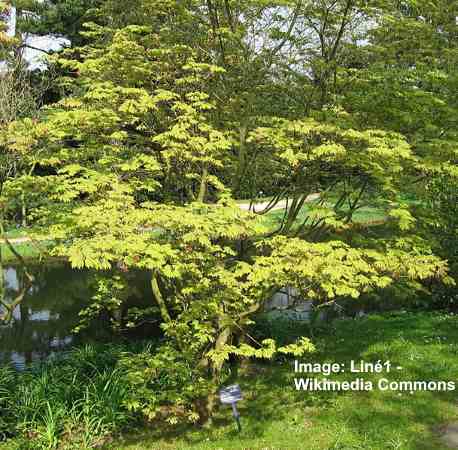
Fernleaf full moon maple (Acer japonicum ‘Aconitifolium’)
The dwarf ornamental full moon maple is a small deciduous tree with attractive feathery foliage. This small maple tree has gorgeous finely-dissected palmate leaves with nine to 11 lobes. Popular as an ornamental landscaping tree, this dwarf Japanese maple grows 7 ft. (2.1 m) tall and 10 ft. (3 m) wide.
The full moon maple ‘Aconitifolium’ is a low-maintenance maple tree suitable for landscapes in USDA zones 5 to 7. In the fall, the tree’s foliage transforms from green into vibrant shades of yellow, orange, and crimson red.
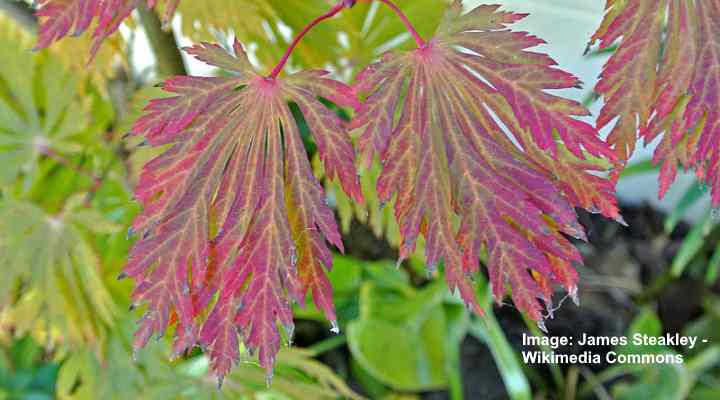
Fernleaf full moon maple autumn leaves
Maple tree leaves: This full moon maple cultivar is identified by its finely-dissected maple leaves with many deeply cut lobes giving the foliage a lacy appearance.
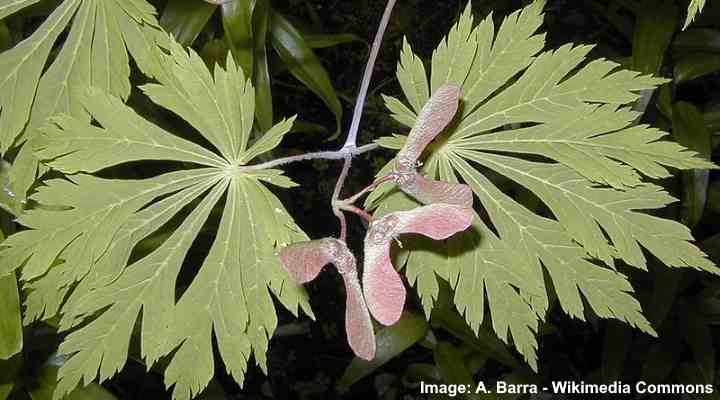
Acer japonicum aconitifolium leaves and samaras
Maple tree bark: The bark on the full moon maple cultivar is dark brown to dark gran and relatively smooth.
Variegated Box Elder Maple (Acer negundo ‘Variegatum’)
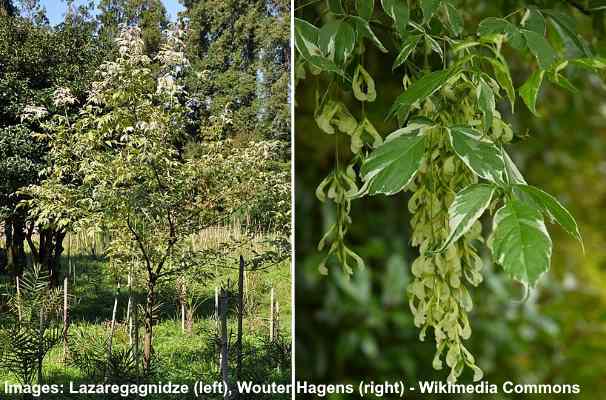
Variegated box elder maple (Acer negundo ‘Variegatum’) young tree and leaves
The variegated box elder maple is an attractive large tree with creamy-white and green foliage. The fast-growing maple has an upright habit and a rounded canopy of attractive leaves. The unusual maple leaves are pinnately compound leaves with three to five leaflets. Compared to other maples, boxelder maples have the longest samaras.
The boxelder variegated maple tree thrives in USDA zones 5 through 8. In full sun, the tree grows 40 to 50 ft. (12 – 15 m) tall and 25 to 35 ft. (7 – 10 m) wide.
Maple tree leaves: The variegated box elder maple has green leaves with creamy-white margins. The leaflets are lanceolate-shaped and grow 2” to 4” (5 – 10 cm) long.
Maple tree bark: The bark of the variegated box elder maple is light to dark brown and has interlocking ridges.
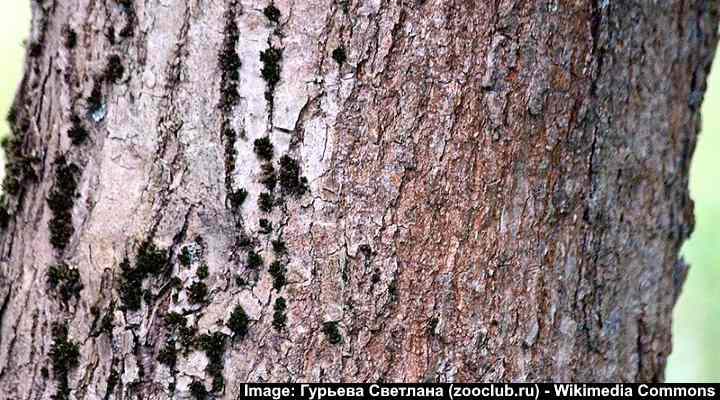
Variegated box elder maple bark
Japanese Maple ‘Katsura’ (Acer palmatum ‘Katsura’)
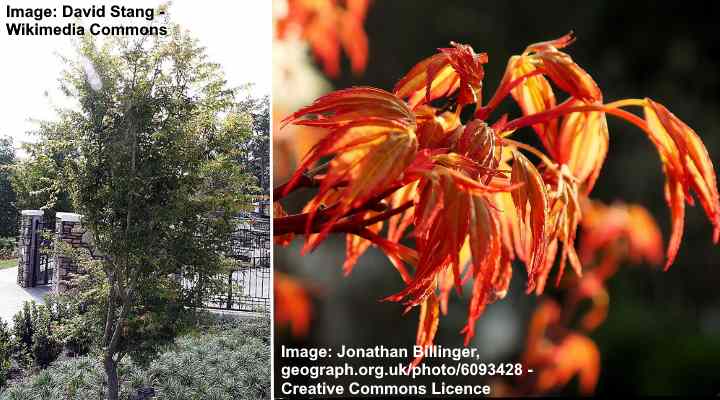
Japanese Maple ‘Katsura’ (Acer palmatum ‘Katsura’) tree and autumn leaves
This beautiful Japanese maple cultivar ‘Katsura’ is an ornamental tree with spectacular pink-edged orange leaves. Like all Japanese maples, this cultivar has lacelike leaves consisting of five to seven thin, toothed lobes. The leaves emerge orange, turn bright green and then become shades of orange and yellow in the fall.
The small decorative maple tree grows 5 to 9 ft. (1.5 – 2.7 m) tall and wide. Its spreading vase shape creates an attractive focal point in a landscape. This small maple is popular for its attractive foliage and shapely habit.
Maple tree leaves: The Japanese maple ‘Katsura’ has colorful palmate leaves growing up to 5” (13 cm) across. In summer, the leaves are green with orange edges. Each leaf has serrated strap-like pointed lobes.
Maple tree bark: The Japanese maple ‘Katsura’ bark is red on new growth and gradually darkens to dark green or brown.
Laceleaf Japanese Maple ‘Garnet’ (Acer palmatum var. dissectum ‘Garnet’)

Laceleaf Japanese maple ‘Garnet’ (Acer palmatum var. dissectum ‘Garnet’)
One of the most ornamental dwarf maple trees is the Japanese maple cultivar ‘garnet.’ This outstanding maple tree has pinkish-red, deeply cut, dissected leaves growing on arching branches. The attractive leaves turn red-orange before becoming vibrant red in the fall. This mounding, cascading shrub-like tree makes a strong statement in a garden landscape.
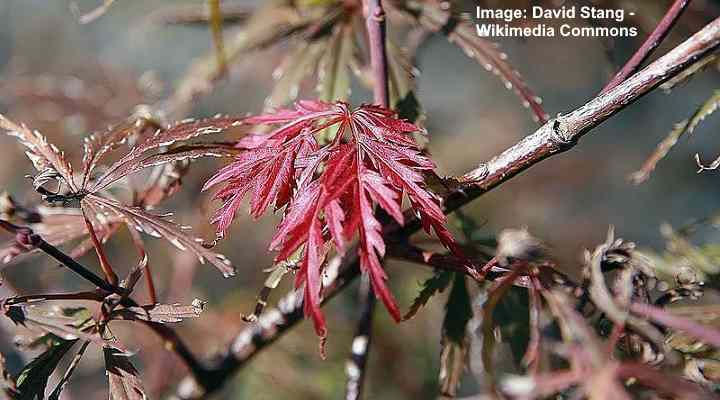
Laceleaf Japanese maple ‘Garnet’ leaves
The laceleaf Japanese maple ‘Garnet’ is easy to grow in full sun or part shade. It’s tolerant of heat and performs best in USDA zones 5 through 9, making it suitable for landscaping in southern gardens. The ornamental maple grows 6 to 8 ft. (1.8 – 2.4 m) tall and up to 12 ft. (3.6 m) wide.
Maple tree leaves: The decorative leaves of the laceleaf maple ‘Garnet’ cultivar have deeply cut leaves giving them a lacy appearance.
Maple tree bark: The Japanese maple ‘Garnet’ bark is relatively smooth and has a pale gray to light brown color.
Related articles:
- Japanese Maple Trees to Grow in the Garden
- Dwarf Japanese Maples – Identification
- Plants for Landscaping Under Maple Trees
